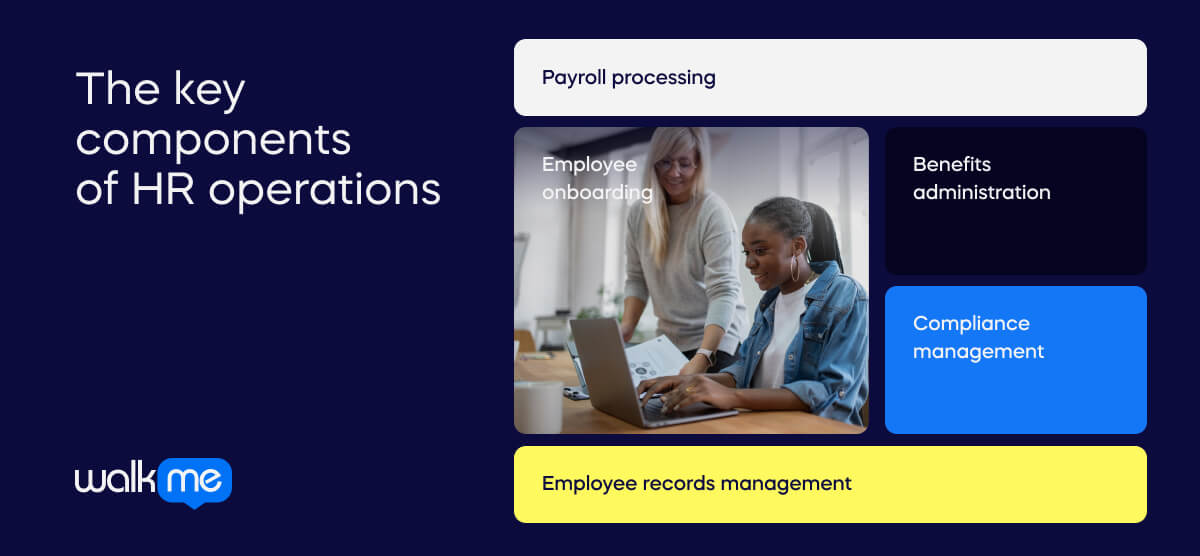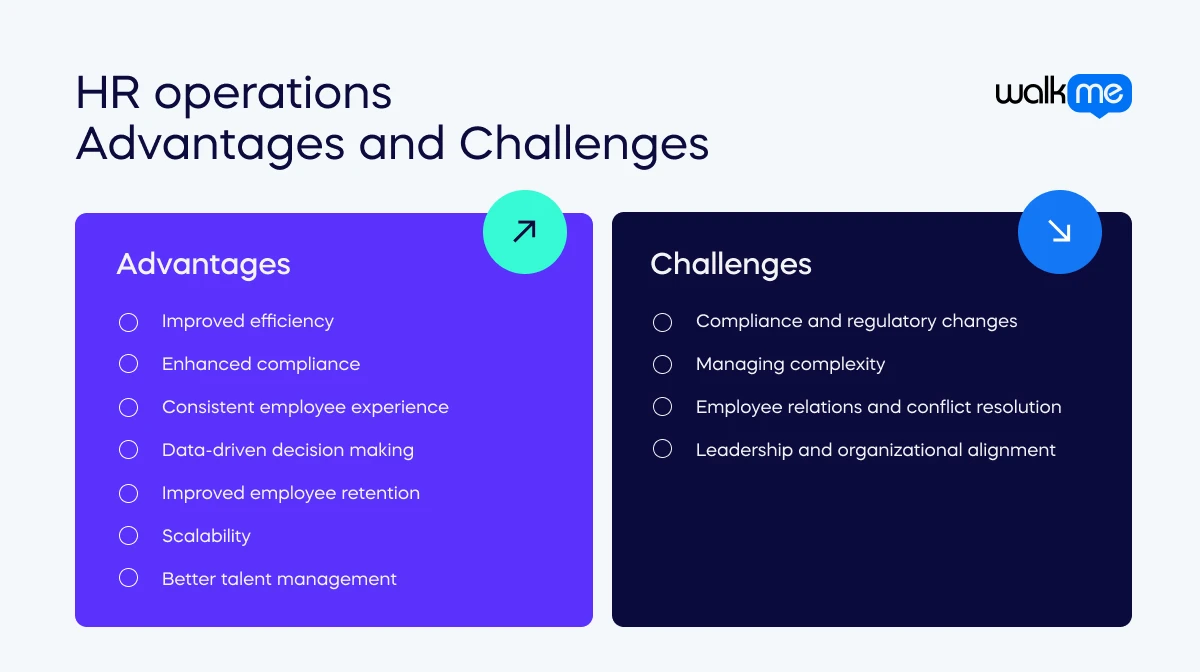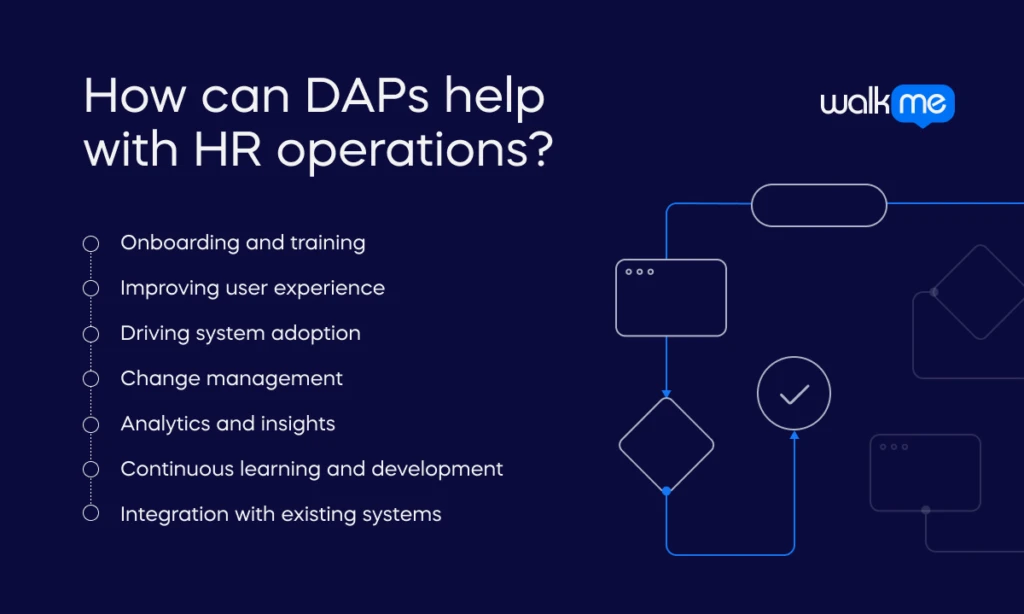HR operations

HR operations are the essential functions and services that support managing a company’s human resources. They are also known as HR services or HR administration. Many activities fall under HR operations, such as employee onboarding, payroll processing, benefits administration, compliance with labor laws, and handling employee records. These operations ensure that all processes relating to employees run smoothly and efficiently. They contribute to the productivity and satisfaction of the workforce. Research reveals that happy employees work harder—a UK university found that happiness makes workers 12% more productive.
Furthermore, workplaces that do not put effort into engaging their teams lose $8.9 trillion in global GDP. When HR operations run smoothly, other departments, such as talent management, can focus on broader organizational goals. This is because it manages the administrative and procedural parts of HR, such as maintaining accurate employee data and ensuring timely payment. HR operations also help reduce errors, ensure compliance with legal requirements, and enhance the employee experience with reliable support and resources.
What are the key components of HR operations?

Several key components ensure the success of HR operations. Understanding them is vital for businesses that want to manage their human resources effectively. The following features provide a solid foundation for effective HR practices:
Employee onboarding
The processes required to integrate new hires into the company include orientation, training, and completing paperwork. When onboarding is effective, new employees are well-prepared, up to speed on company policy, and in a good place to quickly become productive team members.
Payroll processing
The administration of salaries involves calculating relevant bonuses and deductions. Processing payroll involves making sure employees are paid accurately and on time. Not only does this maintain trust and satisfaction, but it also means the company remains compliant.
Benefits administration
Managing benefits programs for employees. These can include retirement plans, health insurance, and paid time off. Effective management ensures employees are more likely to stay with the company for an extended period.
Compliance management
Ensuring the organization adheres to labor laws, regulations, and internal policies. This involves monitoring changes in legislation, conducting audits, and implementing necessary changes to HR practices. Maintaining compliance helps avoid legal issues and promotes a fair and ethical workplace.
Employee records management
Maintaining accurate and up-to-date employee information, including personal details, employment history, and performance evaluations. This is critical for informed decision-making and ensuring compliance with data protection regulations.
HR operations vs. people operations
It can be easy to think of HR operations and people operations as one and the same, but this isn’t accurate. In fact, the terms represent distinct approaches within human resource management.
- HR operations focus on the administrative and procedural aspects of managing employees.
- People operations take a more strategic and holistic view, emphasizing employee experience and organizational culture.
Let’s take a closer look:
| HR operations | People operations | |
| Definition | The administrative functions involved in managing an organization’s workforce. Includes payroll, benefits administration, compliance, and record-keeping. | A broader, strategic approach to managing employees. It focuses on optimizing the employee experience, enhancing engagement, and aligning HR practices with business goals. |
| Focus | Ensuring efficient and accurate execution of day-to-day HR tasks and maintaining compliance with legal requirements. | Creating a positive workplace culture, improving employee engagement and satisfaction, and aligning HR initiatives with overall strategic objectives. |
| Techniques | Standardized procedures for: Payroll processing Benefits administration Compliance audits Maintaining employee records These techniques ensure operational efficiency and legal compliance. | Employee feedback mechanisms Performance management systems Career development programs Initiatives aimed at improving workplace culture These methods are designed to enhance employee well-being and productivity. |
| Goals | Ensure smooth HR processes Maintain legal compliance Provide accurate and timely administrative support | Fostering a positive and productive work environment Enhancing employee engagement Supporting the organization’s strategic objectives |
| Examples of use | Processing payroll on schedule Managing health insurance enrollments Conducting compliance training Maintaining up-to-date employee records | Implementing employee wellness programs Developing leadership training initiatives Conducting regular employee satisfaction surveys Designing performance incentive systems |
Use cases for HR operations
HR operations are crucial in a variety of business scenarios. Whether streamlining the onboarding process for new employees, managing performance reviews, or handling employee disputes, HR operations ensure that HR functions are carried out smoothly and efficiently. It can be challenging to grasp how HR operations manifest in different contexts, so here are three examples to illustrate their roles in more detail.
Onboarding new employees
- A mid-sized tech company hires a new software developer.
- The HR team ensures the new hire completes all needed paperwork, including tax forms, contracts, and non-disclosure agreements.
- An orientation session introduces the new hire to company policies, culture, and team. It also schedules any needed training on company tools and processes.
- Coordination with IT is arranged to ensure that the new employee has access to all needed systems, including email accounts, project tools, and software licenses.
- During the initial period, ongoing support is provided to answer questions, provide resources, and help the new employee integrate smoothly into the company.
Managing employee performance
- An international retail chain conducts annual performance reviews for its store managers.
- A standardized performance review process is developed and implemented, including criteria for evaluation and templates for performance review documents.
- Training sessions are scheduled for managers on how to conduct effective performance reviews and provide constructive feedback.
- Performance data is gathered from various sources, such as sales figures, customer feedback, and peer reviews, to ensure a comprehensive evaluation.
- Coordination of one-on-one review meetings between managers and their supervisors is arranged, ensuring that feedback is documented and action plans for improvement or development are followed up.
Handling employee relations and disputes
- A large manufacturing company faces a dispute between a supervisor and several employees over working conditions.
- A thorough investigation into the dispute is conducted, including interviews with the supervisor, employees, and any witnesses and a review of relevant documentation and company policies.
- Mediation sessions between the involved parties are facilitated to discuss issues, find common ground, and work toward a resolution.
- Company policies related to the dispute are reviewed to ensure they are up-to-date and enforced consistently. If necessary, policies are updated to prevent similar issues in the future.
- Resources such as counseling services or training programs are provided to help improve workplace conditions and relationships.

What are the advantages of HR operations?
HR operations offer numerous advantages for businesses. Optimizing each function can improve efficiency and compliance everywhere. It’s also good for creating a consistent employee experience. As a result, organizations can enjoy cost savings, better talent management, and the perks of having employees stay for longer. Let’s explore in more detail the many benefits of effective HR operations.
Improved efficiency
HR operations streamline administrative tasks. These tasks include processing payroll, managing benefits, and ensuring compliance. This allows HR professionals to focus more on strategic initiatives, such as talent development and organizational growth.
Enhanced compliance
HR operations help reduce legal risks by keeping up-to-date records and ensuring adherence to labor laws and regulations. This ensures that the company stays compliant with relevant employment laws, reducing the likelihood of fines and legal issues.
Consistent employee experience
HR operations standardize hiring, onboarding, performance management, and employee relations processes. This consistency ensures that all employees have the same experience. It promotes fairness and satisfaction across the organization.
Data-driven decision making
Efficient HR operations involve collecting and analyzing employee data. This data-driven approach allows HR to make informed decisions, and it can be used for workforce planning, employee engagement, and retention.
Improved employee retention
Effective HR operations contribute to a positive work environment by ensuring that employee needs are met promptly and accurately. This can improve employee satisfaction and boost retention rates by creating a supportive and well-organized workplace.
Scalability
A well-structured HR operations framework can easily scale with the organization as it grows. This ensures that HR processes remain effective and efficient, regardless of the company’s size or complexity.
Better talent management
HR operations enable more efficient talent acquisition, onboarding, and development processes. This ensures that the organization can attract, keep, and grow top talent, helping it succeed long-term.
What are the challenges of HR operations?
Now, let’s delve into the challenges faced by HR operations. This function’s goal is to simplify processes and help the organization succeed. However, reaching this goal has its hurdles. HR operations face a range of challenges, including navigating complex rules and meeting business goals. These require careful thought and strategic solutions. Let’s examine the key challenges HR operations professionals must address to optimize their impact within organizations.
Compliance and regulatory changes
Navigating and staying updated with constantly evolving labor laws and regulations can be daunting. HR teams must ensure policies follow local, state, and federal laws. This requires continuous monitoring and adjustments.
Managing complexity
As organizations grow or undergo restructuring, HR operations can become more complex. Handling a diverse workforce means negotiating varying employee benefits and employment arrangements, such as remote work and flexible schedules. This requires robust systems and processes.
Employee relations and conflict resolution
Handling employee relations issues, workplace conflicts, and grievances requires sensitivity, fairness, and adherence to organizational policies. Resolving disputes effectively while maintaining positive employee morale is crucial but challenging.
Leadership and organizational alignment
Aligning HR strategies with overall business goals and gaining leadership buy-in can be difficult. Ensuring that HR initiatives contribute to the organization’s success and are understood and supported across all levels is crucial for effectiveness.
How can DAPs help with HR operations?

HR professionals can greatly benefit from using digital adoption platforms in their daily operations. This software improves user adoption, enhances the experience, and supports change management. Furthermore, analytics and insights support continuous improvement. For those wanting to understand how HR software can be elevated within organizations, here are the key benefits of integrating it with a DAP like WalkMe:
Onboarding and training
DAPs provide guided walkthroughs and tutorials. They help new hires and existing employees learn HR systems quickly, reducing the learning curve and ensuring efficient onboarding and training processes.
Improving user experience
The user experience is greatly improved when employees can access personalized support right when needed. Therefore, Workers will be more satisfied and productive as they navigate HR processes.
Driving system adoption
DAPs increase HR technology adoption by providing proactive help and support. Tooltips, pop-ups, and step-by-step instructions help users understand HR systems, making people use them more often and with more confidence.
Change management
DAPs are crucial in change management during change, like rolling out new HR systems or processes. They can guide employees through changes, ensure the changes go smoothly, and reduce resistance to new technologies.
Analytics and insights
DAPs offer analytics and usage metrics. They give HR teams valuable insights into how employees use HR systems. This data helps identify areas for improvement. They can then optimize workflows and tailor training programs to make them more effective.
Continuous learning and development
DAPs provide ongoing guidance and updates. They help HR operations learn and grow. They also empower employees to explore HR software’s advanced features at their own pace, which promotes skill development.
Integration with existing systems
DAPs can integrate seamlessly with existing HR systems, enhancing their functionality without the need for significant changes or disruptions to current workflows.